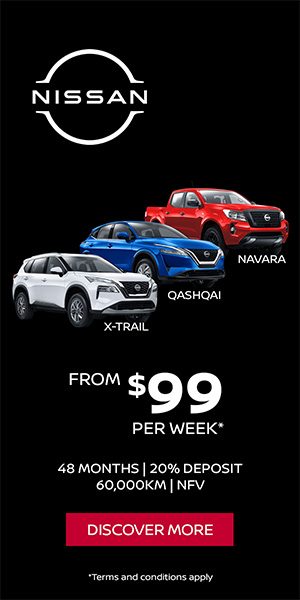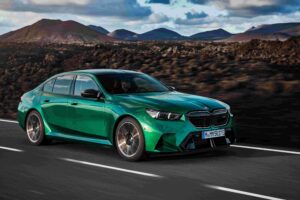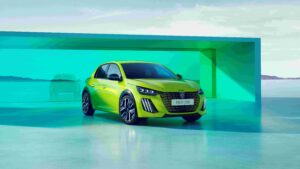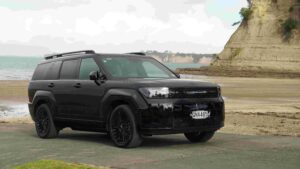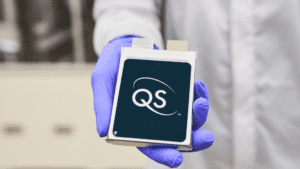Under strict embargo, Audi’s new e-tron, the Q4 Sportback has now shown its face to the world but you’ll still have to wait a bit to see it in New Zealand.
From a technical perspective, the Q4 e-tron and Q4 e-tron Sportback are identical twins, but in terms of their shape, they each have their own unmistakable and characteristic features.

The silhouette of the Sportback slopes downward to the back in a subtle and dynamic curve. The roof line transitions into the significantly inclined D-pillars and ends in a horizontal spoiler at the level of the lower window edge. As a result, the future Audi Q4 Sportback appears much longer than its sister model, the Q4 e-tron concept.
The striking broad light band that connects the two lamp units on the rear end of the Audi Q4 Sportback e-tron concept was incorporated to reflect an element of the Audi Q4 e-tron concept. It is clearly visible even here that these two models belong to the same e-tron family, as the close relation to the e-tron Sportback* is obvious. This also applies to the inside of the lights, where the significant sweep of the LED segments is also reminiscent of an element of the older brother. The striking design of the bumper diffuser unit with its horizontal slats and the illuminated e-tron logo in the middle is an element that the two Q4 versions share.

When looking at it from the front, the Singleframe with the four rings brand logo identifies the Q4 Sportback e-tron concept as an Audi vehicle. And it will take no more than two glances to see that this is an electric Audi: Like the first production Audi with electric drive, the new concept vehicle also features a structured closed surface within a broad, almost upright octagonal frame in place of a traditional radiator grille.
The prominently modeled fenders of all four wheels are a further classic Audi design feature that has distinguished the brand since the legendary original quattro 1980. The widened features of the Q4 e-tron concept and Q4 Sportback concept are designed to be highly organic and flowing, and they add a characteristic touch to the side view. The accentuation of the rocker panel area between the axles, where the battery and thus the powerhouse of this SUV is located, is a typical feature of the e-tron. Large 22-inch wheels leave no doubt as to the potential of the newest member of the Audi family.
The Q4 Sportback e-tron concept is painted in the new kinetic gray color, a light metallic and pearl effect color that takes on a distinct greenish tinge depending on the angle of the light. In contrast, the lower sections of the body are painted in a dark gray color. This segmentation emphasizes the width and horizontal orientation of the vehicle’s architecture.

With its dimensions, the Audi Q4 Sportback e-tron concept also takes its position in the upper third of the compact class. Its road space requirements qualify the electric SUV as an agile all-rounder. In terms of the interior, by contrast, its wheelbase of 2.77 meters (9.1 ft) puts it at least one class higher. As there is no transmission tunnel restricting the space, the Q4 Sportback e-tron concept offers unsuspected spaciousness and comfort, especially in terms of legroom at the front and even more in the rear.
The color scheme emphasizes the sense of spaciousness. While light, warm colors dominate the upper section of the cabin, the dark carpet in the floor section provides a contrast. The headlining, the window pillars and the upper section of the door rail and dash panel are fitted with white and beige microfiber textiles. Sustainability is the top priority not only in terms of the electric drive in the Audi Q4 and Q4 Sportback: The floor covering is made of recycled materials. Instead of chrome-plated metal decor frames, the surfaces are covered with a high-quality multi-layer paint finish. The painted frosted Plexiglas on the applications creates an intensive depth effect. Four seats with integrated head restraints are upholstered with comfortable Alcantara material manufactured with exquisite workmanship. Double seams stitched with thick yarn adorn the upholstery.
The display of the Audi virtual cockpit with the most important display elements for speed, charge level, and navigation is located behind the steering wheel. The large-format head-up display with an augmented reality function is a new feature. It can display important graphical information, such as directional arrows for turning, directly on the course of the road.
Control panels designed as touch elements on the steering wheel spokes can be used to select frequently used functions. In the middle above the center console, there is a 12.3-inch touchscreen via which the infotainment and vehicle functions are displayed and operated. It is tilted toward the driver for greater ease of operation. A strip of buttons for controlling the air conditioning is located below it.
As the center console does not need to hold functional elements such as a gear lever or hand brake actuation elements, it is designed as a spacious stowage compartment that includes a cell phone charging cradle. There is a horizontal area in high-quality design into which the selector button for the transmission mode is integrated and that also serves as a cover for the front section of the console. In addition to the conventional lower storage compartment, the doors now provide the possibility to store bottles in the specially molded upper section, where they are easy to reach.
The modular electrification platform (MEB) offers a broad range of drive variants and power levels. The performance version of the electric drive is installed in the Audi Q4 Sportback e-tron concept. The front and rear axles are each powered by an electric motor – this Q4 Sportback is a quattro. There is no mechanical connection between the axles. Instead, an electronic control ensures that the torque distribution is coordinated optimally, and it does so in fractions of a second. That enables the SUV Coupé to achieve optimum traction in all weather conditions and on any type of surface.
In most cases, the Q4 Sportback e-tron concept mainly uses its rear electric motor, a permanently excited synchronous motor, in order to achieve the highest efficiency. For reasons of efficiency, the drive torque is generally distributed with a rear-axle bias.

If the driver demands more power than the rear electric motor can supply, the electric all-wheel drive uses the front asynchronous motor to redistribute the torque as required to the front axle. This also happens predictively even before slip occurs in icy conditions or when cornering fast, or if the car understeers or oversteers.
The electric motor in the rear end has an output of 150 kW and mobilizes a torque of 310 newton meters (228.6 lb-ft); the front motor supplies the front wheels with up to 75 kW and 150 newton meters (110.6 lb-ft). The system output is 225 kW. The battery in the vehicle floor stores 82 kilowatt hours, which allows for a range of more than 450 kilometers (279.6 mi) according to the WLTP standard. The battery is charged with a maximum of 125 kilowatts. It therefore takes little more than 30 minutes to reach 80 percent of the total capacity.
However, the recipe for this excellent range involves far more than just an energy storage unit with a large capacity. Just like the first member of the family, the Audi Q4 e-tron concept, the Audi Q4 Sportback also presents itself as an efficiency virtuoso, starting with the low aerodynamic drag of the body, whose drag coefficient is 0.26 and therefore 0.01 below that of the Q4 e-tron SUV. The compact electric product line also features a sophisticated recuperation strategy, leaving out no possibility for optimizing its range. The complex thermal management of the drive and battery, which involves a CO2 heat pump, also contributes to this.
A key factor for the sporty character and outstanding transverse dynamics is the low and central position at which the drive components are installed. The high-voltage battery system is optimally matched to the dimensions of the Audi Q4 Sportback and is located between the axles in the form of a flat, broad block beneath the passenger compartment. The battery system weighs 510 kilograms (1,124.4 lb). The center of gravity of the Audi Q4 Sportback e-tron concept is therefore at a similar level to that of a sedan with a conventional drive system.
Axle load distribution is perfectly balanced at almost 50:50. The front wheels of the Q4 Sportback e-tron concept are guided on a MacPherson axle with adaptive dampers. In the rear, there is a multi-link axle with separate springs and adaptive dampers.

This new Sportback gives potential Audi Q4 customers the opportunity to start thinking about which version they prefer roughly a year before the first vehicles will be delivered: the versatility and robustness of the classic SUV or the dynamic elegance of the Coupé variant.
Production version to be launched in 2021, (expect the Kiwi early adopters to get theirs delivered soon after that) as the Audi brand’s seventh electric model. Contact Audi New Zealand for more details.

